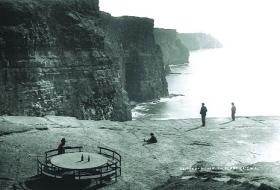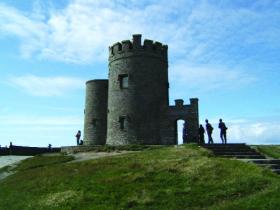Cornelius O’Brien and the Cliffs of Moher
Published in 18th–19th - Century History, Issue 2 (Mar/Apr 2007), News, Volume 15
The iron picnic table built by O’Brien for the convenience of visitors. (National Library of Ireland)
The Cliffs of Moher have long been admired for their scenic beauty, but few know much about the man who first promoted tourism to this inspiring place. Cornelius O’Brien, a benevolent local landlord, was the first to formally recognise the cliffs as a tourist destination. Samuel Lewis reported in 1833 that O’Brien was erecting ‘an ornamental building in the castellated style . . . for the accommodation of visiters [sic] to this bold and iron-bound coast, from which is obtained a magnificent view embracing nearly the whole line of coast from Loop Head to the northern extremity of the bay of Galway, together with the Arran Isles [sic] and a vast expanse of the Atlantic Ocean . . .’. In order to make the cliffs accessible, safe and attractive, O’Brien also built stables and an iron picnic table for the convenience of visitors, whom he frequently entertained at Birchfield, his nearby estate. His only surviving son, George, continued his father’s hospitality to strangers.
Cornelius O’Brien (c. 1782–1857) was born around 1782 at Birchfield, Liscannor, Co. Clare, the third son of Henry O’Brien of Birchfield and Ennis. He was educated by Stephen O’Halloran in Ennis, entered the King’s Inns, Dublin, in the Hilary term of 1803, and graduated as an attorney in the Easter term of 1808. He was a proctor, solicitor and magistrate for County Clare, with a business address in Dublin. Throughout his career, however, his primary place of residence was his estate at Birchfield.
O’Brien was elected MP for County Clare on 1 December 1832, but he was clearly involved in local politics before this date. He was a member of the committee that selected Daniel O’Connell to run in the 1828 election. His own politics were liberal, pro-Repeal and pro-secret ballot and tenants’ rights. He held his seat in Westminster from 1832 to 1857, losing only once, in 1847. Advancing age and ill health forced his retirement from parliament in March 1857, two months before his death on 30 May 1857.
Apart from his estate at Birchfield in the townland of Beaghy (Kilmacrehy), Cornelius O’Brien’s holdings in Clare were extensive. In 1829 the Birchfield estate was valued at £50, and his role as an improving, resident landlord is an important aspect of the man. The Griffith Valuation in 1855 showed that he held 9,679 acres, spread across seventeen parishes and 36 townlands of County Clare, and had 275 tenants. Jonathan Binns, assistant agricultural commissioner in 1837, noted the great number of whitewashed and comfortable cottages scattered over the O’Brien estate, an indication of the care and attention of the owner. O’Brien sometimes provided his tenants with a car to bring in lime from Doolin, and in times of need he supplied the poor with wool and potatoes in lieu of labour.

O’Brien’s Tower, the Cliffs of Moher’s first ‘visitor centre’, described by Samuel Lewis in 1833 as ‘an ornamental building in the castellated style’. (Perry McIntyre)
O’Brien’s care of his tenants continued through the Famine, with some evidence that he waived rent. In an angry debate at a meeting of the Liscannor famine relief committee, George Westropp, agent for Dean Stacpoole, accused O’Brien of favouring his own tenants in the allocation of relief work. O’Brien replied that if Westropp had the slightest compassion in such a year he would not have taken rent from his poor tenants and would have told them to take back their money and buy some bread with it. It is unlikely that O’Brien would have made such a statement if he himself was charging rent.
Harriet Martineau visited Clare in the wake of the Famine in September 1852. As she travelled from Galway along the coastal route to Clare, she described scenes of utter desolation until she came to the whitewashed dwellings of O’Brien’s tenants. She was not the only contemporary observer to note him as a kind landlord. His care and expenditure in making the Cliffs of Moher accessible, safe and attractive to visitors made him popular among his tenants, who were given employment when little else was available.
Cornelius O’Brien engaged in numerous building projects, beginning with the construction of Birchfield House before 1816, the year he married Margaret Long. His next project was the relocation and upgrading of St Bridget’s Well at Kilmacrehy from higher up the hillside to its present location beside the road. Here he erected the well-house and rustic seating for his tenants. He then turned his attention to the dangerous ford across the river between Lahinch and Liscannor, where in 1833 he facilitated the building of a fine stone bridge of three arches, known as O’Brien’s Bridge, which remains to this day. In 1845 he built a boys’ and girls’ national school beside the main road to St Bridget’s Well. He also erected a little Gothic structure over the nearby Reliever’s Well.
Cornelius O’Brien was on many committees and was chairman of the Ennistymon Poor Law Union from its formation on 25 August 1839. The workhouse opened in September 1842 and, along with five auxiliary workhouses, by 1853 provided accommodation for 3,618 inmates. The minutes reveal that O’Brien was very active in the weekly meetings and on the subcommittees that worked to improve roads, to house people evicted by their landlords during the Famine, and to obtain suitable contracts for the supply of a variety of needs for the workhouses, including additional accommodation.
There are no known portraits of Cornelius O’Brien, but two monuments other than O’Brien’s Tower remain to memorialise a man who has been overshadowed by the more powerful Thomond O’Brien families, particularly Lucius and William Smith O’Brien (leader of the rebellion of 1848). In mid-October 1854 the first meeting of a testimonial committee took place in Ennis at the office of the Clare Journal and Ennis Advertiser. Sir Colman O’Loghlen QC presided, and there was a unanimous decision to erect a testimonial as a mark of appreciation for the successful efforts of Cornelius O’Brien of Birchfield to improve the condition of the middle and lower classes in his neighbourhood, including encouraging their education. Mention was also made of the accommodation he afforded to all classes visiting the Cliffs of Moher and surrounding scenery. There was much debate about the form of the testimonial, and by the time a sketch of the proposed monument appeared in the press in November 1855 donations amounted to more than £400. The sketch shows O’Brien on top of a column similar in style to Daniel O’Connell’s in Ennis or Nelson’s in Dublin’s Sackville Street and London’s Trafalgar Square. Despite the inscribed date (14 October 1853) it was not completed until after his death, and was certainly not built by him as self-aggrandisement, as is often wrongly claimed.
The other remaining monument to Cornelius O’Brien is his family plot in the nearby cemetery above St Bridget’s Well. It was built for his son, John Cornelius O’Brien, a lieutenant in the 22nd Regiment Native Infantry, who died at Secunderabad, India, on 28 December 1856, aged 26. Five months later Cornelius himself died and was buried in the family mausoleum. Ten years later his other son, George O’Brien, was also laid to rest there. Thus 1867 saw the end of the O’Brien association with Birchfield House, which today lies in ruins.
The stables and the iron picnic table are long gone from the Cliffs of Moher, but the astute visitor can still see the local testaments to Cornelius O’Brien. His visitors’ tower and the magnificent view that these cliffs have long offered to the casual visitor remain to remind us of Cornelius O’Brien 150 years after his death.
Perry McIntyre is an Australian historian with a strong interest in Irish emigration who regularly brings groups of genealogists to Ireland on tour.
















